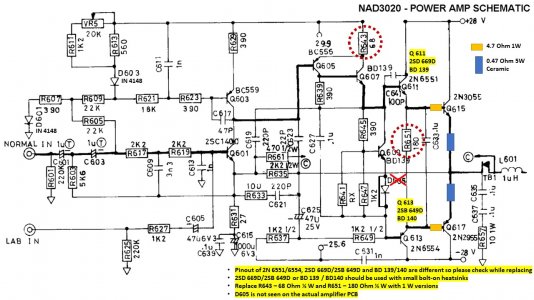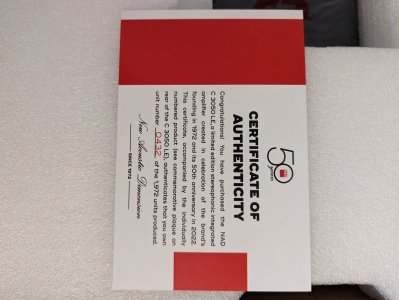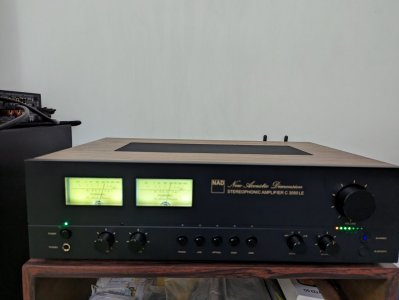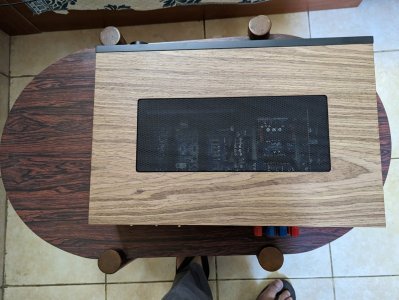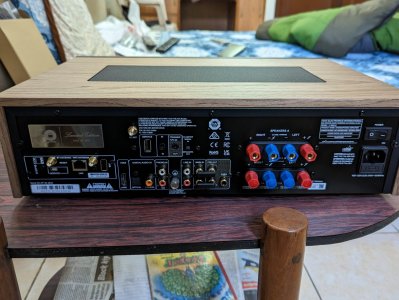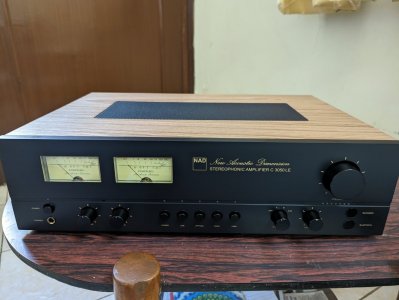Dear all, over the last few months, I received some interesting questions regarding NAD 3020 repairs, thought I'll post these for general reading.
1) A forum member wanted to know why some NAD models are considered unreliable, especially the older version of NAD 3020.
In my opinion, the first version of NAD 3020 had some design issues causing unreliablility over time. Not the circuit design, but with the construction. There are many screws that are very close to the PCB contacts. When servicing this amp, it is very important to put the screws back from where they came as there are smaller screws and longer ones. There are wires running all over the place, the insulation of which, tends to deteriorate with time, components are bent and leaning all over the place due to inconsistant methods of assembly, power transistor insulation from the heatsink also tends to be a problem. A big whammy is the screw which bolts the power transistor heatsink to the chassis, thereby grounding the heatsink. This screw has to be removed. Rough plugging and unplugging of interconnects can damage the PCB causing issues. All these issues can be addressed and the amp can be made very reliable. Some components in the amplifier run warm, especiallly driver transistors, power transistors and pre-driver/preamp powersupply regulator transistors and if anything goes wrong, these components will go into thermal runaway and fail. If your amplifier is smoking, it is a few resistors that are starting to burn out. If you see flashes, your power fuses are blowing, due to burnt output transistors.
2) My NAD 3020's driver transistors 2N6551 and 2N6554 have blown, these are not available any more. What do I do?
Not to worry, 2N6551 (NPN) can be replaced by BD139 and 2N6554 (PNP) can be replaced by BD140. Both BD139 and BD140 are commonly available and cost about Rs.7/- each. Just ensure the following:-
- you can't replace only one, they have to be replaced as a pair with a pair of BD139 and BD140.
- you will have to attach separate small heatsinks to the BD139 and BD140. (check the bias and DC offset just to make sure, but the amplifier will play flawlessly without any difference in quality)
3) When I play at loud volumes, sometimes I see light smoke coming out of my NAD 3020. When I cool down the amplifier and play it again, it plays flawlessly. This happens only when I play at high volume and use 4 ohm speaker loads. What should I do?
There is a 68 ohms resistor and a 180 ohms resistor used in the power amplifier stage which run hot and when they get very hot, they tend to smoke. NAD has used 1/4 watt resistors. These have to be replaced with 1 watt resistors. Please refer to the circuit diagram below for identifying these 2 resistors (only one channel is shown). It is important to note that NAD may have intentionally used 1/4 watt resistors so that they may blow intentionally under certain circumstances.
4) I have an old 3020 amplifier which became faulty when the power fuses blew. The amp was recapped and the power transistors were replaced. The amp was returned in working condition. However after a few hours of listening, the power transistors blew again. The mechanic changed them and after working well for a day, they blew again. This keeps repeating and I cannot use my amplifier any more. What can I do?
There are 5 aspects to be checked. Assuming that your amplifier does not have any PCB related issues, you will have to run checks in the following sequence:
- What brand of power transistors were used as replacements? The Chinese metal cap ones tend to be fake. Prefer to buy BEL Power Transistors especially 2N3055. Yes they are still available.
- Power transistor installation needs to be properly done. Improper thermal contact with the heatsink will lead to failure. The Transistor case (collector) should be electrically insulated from the heatsink
- In the old 3020, there is a jumper hook-up wire connecting the emitters of the power transistors (and circuit breaker) with the rest of the circuit (including the headphone jacks). Check for leakage or potential short circuit, also check the headphone jack
- Biasing and DC Offset calibration needs to be checked
- Now to the most important one - not too many know this. When replacing the 2N3055 and 2N2955 output transistors in NAD 3020 models manufactured prior to 1982, you will have to introduce a small mod to the circuit. The manufacturing process for 2N3055 and 2N2955 was different prior to 1980 and NAD had stock of these pre-1980 transistors which were in use until circa 1981-82. The newer versions of these transistors were manufactured using epitaxial base technology, which allowed the newer versions to be better sounding but more immune to secondary break down when compared to the robust older ones. You will have to add 0.47 ohm emitter resistors for both power transistors for achieving better bias stabilization. You will also have to add 4.7 ohm resistors between the driver and base of each power transistor. This resistor limits the current flowing into the base of the transistor giving it better immunity against breakdown. NAD engineers prescribe 4.7 ohm as it is just sufficient to ensure that each power transistor is fully saturated when switched on. Please refer to the schematic below for details.
5) Please share some "trade-secrets" for repairing NAD amplifiers.
There are no trade-secrets for amplifier repair. Every situation has a reason and a root cause. The ability to identify this and address this, results in a fix. The ability to repair comes with experience. Just like a doctor, the ability to identify potential issues based on the symptoms and prescribe the right 'treatment' results in a fix.
6) When running older amplifiers, does the impedence of the speaker matter?
It is safe to use the standard 8 ohms speaker impedence with older NAD amplifiers. Running at lower impedence loads put a lot of strain on the output transistors and power supply. The amp has to be at its best in order to overcome the strain. Why take these risks? Its not worth

PS: I have collected info related to these mods, based on my vaious interactions with NAD Service technicians at NAD authorized service centers in the US
